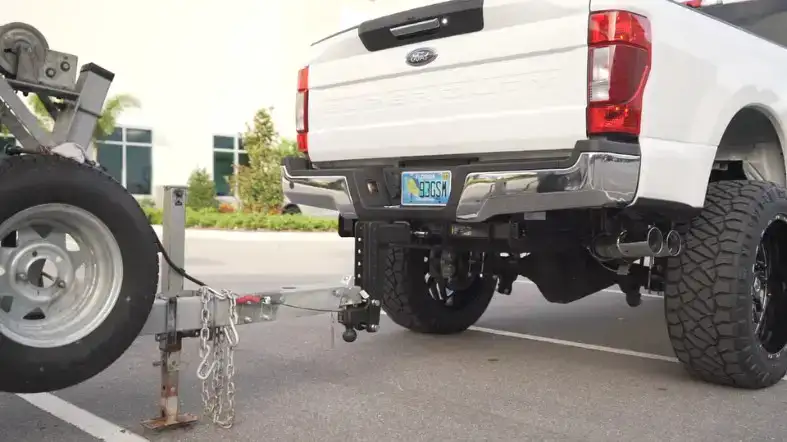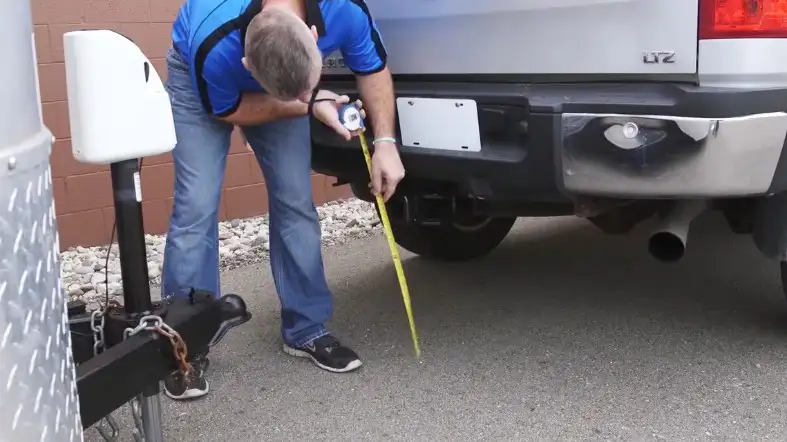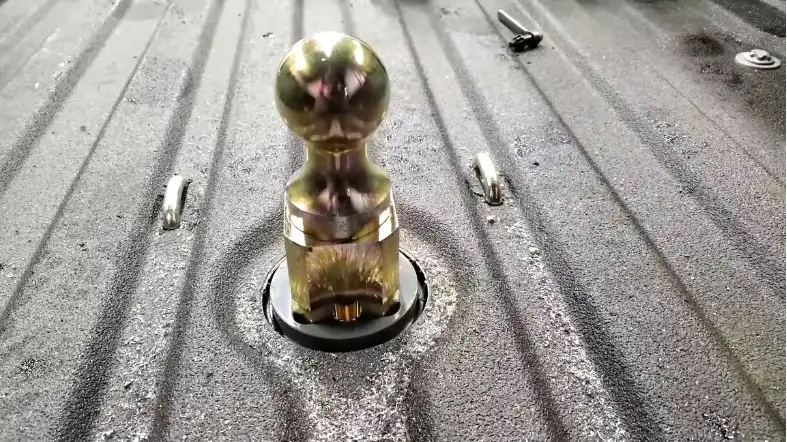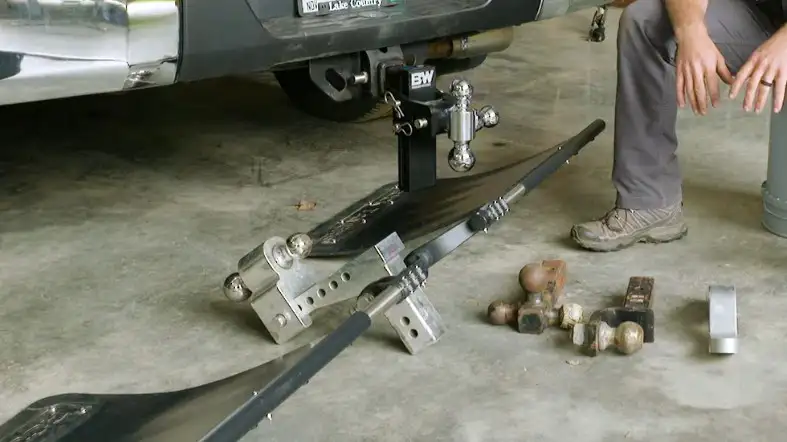The Ford Super Duty is a popular pickup truck known for its power and durability.
When it comes to towing and hauling, the Super Duty has a receiver hitch that can handle a variety of loads.
However, it’s important to choose the right size hitch for your needs.
In this article, we’ll discuss the different receiver hitch sizes for the Ford Super Duty and how to determine the best size for your vehicle.
What is the Ford Super Duty receiver hitch size?
The standard Ford Super Duty receiver hitch size is 2 inches.
So no matter your project or destination you can be confident of having a hitch with plenty of power and durability.

Here is a table given below about the receiver hitch sizes of the Super Duty Models.
| Year | Super Duty Model | Receiver Hitch Size |
|---|---|---|
| 1999-2004 | F-250 | 2″ |
| 1999-2004 | F-350 | 2″ |
| 2005-2007 | F-250 | 2-1/2″ |
| 2005-2007 | F-350 | 2-1/2″ |
| 2008-2010 | F-250 | 2-1/2″ |
| 2008-2010 | F-350 | 2-1/2″ |
| 2011-2016 | F-250 | 2-1/2″ |
| 2011-2016 | F-350 | 2-1/2″ |
| 2017-2020 | F-250 | 2-1/2″ |
| 2017-2020 | F-350 | 2-1/2″ |
How To Measure Your Vehicle To Find The Right Hitch Size?
There are some ways to measure your vehicle to find the right hitch size. Some of them are given below:
1. Find the vehicle’s Gross Trailer Weight (GTW)
The first step in finding the right hitch size for your vehicle is to determine its Gross Trailer Weight (GTW).
The GTW is the total weight of your trailer, including all of your cargo and any other items that may add weight.
You can usually find the GTW listed in your vehicle’s owner’s manual.
2. Find the vehicle’s tongue weight (TW)
The second step is to find the tongue weight (TW) of your vehicle.
The TW is the portion of the GTW that rests on the hitch itself.
This is typically 10-15% of the GTW.

3. Choose a hitch size
Once you know the GTW and TW of your vehicle, you can choose a hitch size.
There are three main types of hitches: Class I, Class II, and Class III.
Class I hitches. If you’re unsure which hitch size to choose, you can always consult with a professional.
4. Install the hitch
Once you’ve chosen a hitch size, it’s time to install it on your vehicle.
This process will vary depending on the type of hitch you have.
5. Test the hitch
After you’ve installed the hitch, it’s important to test it to make sure it’s working properly.
To do this, simply hook up your trailer and give it a few gentle tuggers.
What are the different types of Ford Super Duty hitches?
There are different types of Ford Super Duty hitches. They are-
1. Fifth Wheel Hitch
A fifth-wheel hitch is a type of hitch that is typically used with larger vehicles, such as RVs.
Fifth-wheel hitches are designed to provide a more stable connection between the vehicle and the trailer.
2. Gooseneck Hitch

A gooseneck hitch is a type of hitch that is typically used with trucks.
Gooseneck hitches provide a more stable connection between the tow truck and the trailer.
3. Weight Distribution Hitch
A weight distribution hitch is a type of hitch that is designed to distribute the weight of the trailer evenly across the axle of the vehicle.
This type of hitch is typically used with larger trailers.
4. Bumper Hitch
A bumper hitch is a type of hitch that mounts to the bumper of the vehicle.
Bumper hitches are typically used with smaller trailers.
5. Receiver Hitch
A receiver hitch is a type of hitch that mounts to the frame of the vehicle.
Receiver hitches are typically used with larger trailers.
How To Choose The Right Type Of Hitch For Your Needs?
Now you know about ford super duty receiver hitch size.
Here are some tips on how to choose the right type of hitch for ford super duty.
1. Decide what type of trailer you will be towing
The first step in choosing the right hitch is to determine what type of trailer you will be towing.
There are three main types of trailers: travel trailers, fifth wheels, and pop-ups.
Travel trailers are the most popular type of trailer and can be towed by most vehicles.
Fifth wheels are larger than travel trailers and require a special hitch that mounts in the bed of a pickup truck.
Pop-ups are the smallest type of trailer and can be towed by most vehicles.

2. Determine the weight of your trailer
The next step in choosing the right hitch is to determine the weight of your trailer.
The weight of your trailer will determine the size and type of hitch you need.
For example, if you have a travel trailer that weighs less than 5,000 pounds, you will need a Class II hitch.
If you have a travel trailer that weighs more than 5,000 pounds, you will need a Class III hitch.
3. Consider the tongue weight of your trailer
Another important factor to consider when choosing a hitch is the tongue weight of your trailer.
Tongue weight is the portion of the trailer’s weight that rests on the hitch receiver.
It is important to choose a hitch with a tongue weight capacity that exceeds the tongue weight of your trailer.
Otherwise, your vehicle could become unstable while driving.
4. Select a hitch with the right ball mount height
Another factor to consider when choosing a hitch is the ball mount height.
The ball mount is the part of the hitch that attaches to the tow vehicle and supports the trailer coupler.
It is important to choose a ball mount with a height that matches your vehicle’s bumper height. Otherwise, your vehicle could become unbalanced while driving.
5. Choose a hitch that fits your budget
Finally, you will need to choose a hitch that fits your budget.
Hitches can range in price from $50 to $500 or more depending on their features and quality.
It is important to choose a hitch that is durable and easy to use so you can enjoy many years of safe and trouble-free towing
FAQs about Ford Super Duty Receiver Hitch Size
What Size Hitch Receiver Does A Ford Super Duty Come With?
If you own a Ford Super Duty, you probably want to know all the ins and outs of it, such as what size hitch receiver it comes with.
Well, lucky for you, this hardworking truck comes with an industry-standard Class V 2-inch hitch receiver that is capable of towing up to 21,000 lbs.
Equipped with a generous tongue weight capacity of 4,200 lbs.
the Ford Super Duty can pull even heavy loads over level roads or through hills and mountains.
How Much Weight Can A Ford Super Duty Receiver Hitch Hold?
The Ford Super Duty receiver hitch is one of the toughest hitches available on the market, offering unmatched strength and reliability.
It features a 12,000-pound weight distribution capacity and a 21,000-pound gooseneck towing capacity, allowing you to confidently haul large loads with ease.
What Is The Towing Capacity Of A Ford Super Duty With A Receiver Hitch?
When you’re in the market for a reliable, durable truck to transport large or heavy items, capacity is an important factor.
Luckily, the Ford Super Duty has got your back with an impressive towing capacity of 17,000 lbs. when equipped with a receiver hitch.
With its legendary durability and robust towing capability, there’s no doubt that the Super Duty will help you get the job done right!
What Are Some Receiver Hitch Accessories I Can Get For My Ford Super Duty?
Whether you are towing a boat or hauling heavy cargo, having the right accessories for your Ford Super Duty receiver hitch can make all the difference.
From ball mounts, adjustable length drop receivers, cargo carriers, bike racks, mountable work tables, and more – there is something for every individual and their towing needs.
To guarantee that any accessory used with your Super Duty receiver hitch is able to stand up to anything you can throw at it – look out for products made from strong and solid materials such as steel or aluminum.
Conclusion
Ford has produced a receiver hitch that is rated to tow up to 20,000 pounds.
If you are looking for a durable and reliable hitch for your super-duty truck, this is the one you want.
The Ford super-duty receiver hitch size will allow you to tow whatever you need with ease.
